
Fora’s Take
London and its surrounding landmarks have long been on the must-see list—and for good reason. From the iconic Tower Bridge and Big Ben to the regal Buckingham Palace and the ancient mystique of Stonehenge, the trip didn’t disappoint. Immersing yourself in British culture, history and food makes it an unforgettable experience. Whether you're strolling through the historic streets or taking in the sights and sounds of British tradition, this destination is a must-visit for any traveler. If these landmarks are on your list, we highly recommend making this trip—it lives up to every expectation and more.
The Fora Difference
Book with our team of advisors to unlock exclusive perks and discover hidden gems.
Killer perks
Free upgrades, spa credits and more—we got you
Personalized recs
Customized travel planning for your style
Insider knowledge
Expert advice from people who’ve actually been there
Where to stay in London
Unlock perks by contacting our team of advisors to book your trip.
Traveler's Hack: When flying internationally, a sleep mask, earplugs, neck pillow and a cozy jacket or hoodie are absolute essentials. These little comforts help you snag those precious hours of sleep so that you can hit the ground running as soon as you land. After all, your time while traveling is priceless—you want to maximize it with exciting activities, not waste it adjusting to a new time zone!
Sleeping is for the uninspired. We’re here to get things done and make the most of every moment. So gear up, get comfortable and get ready to explore from the minute your plane touches down!
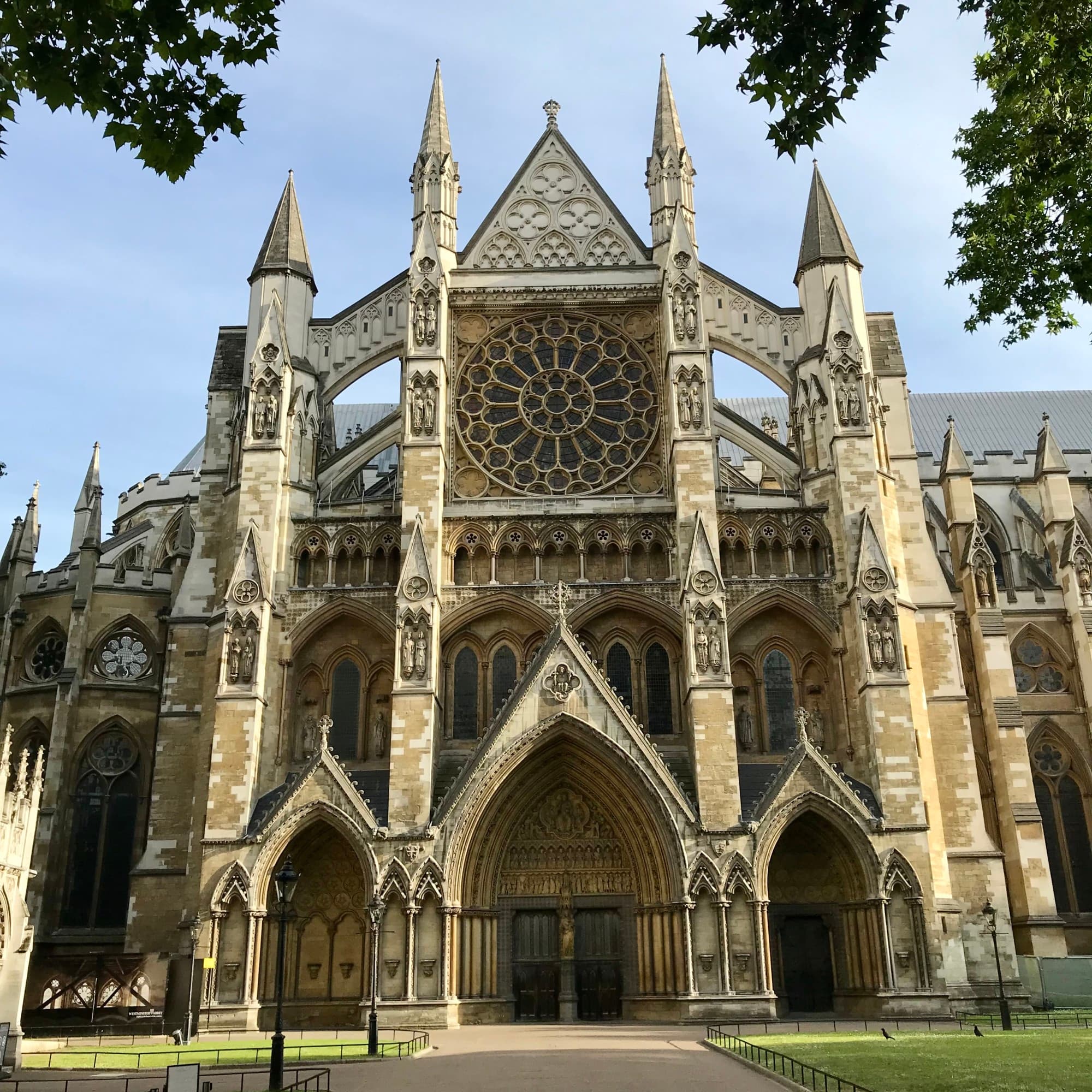
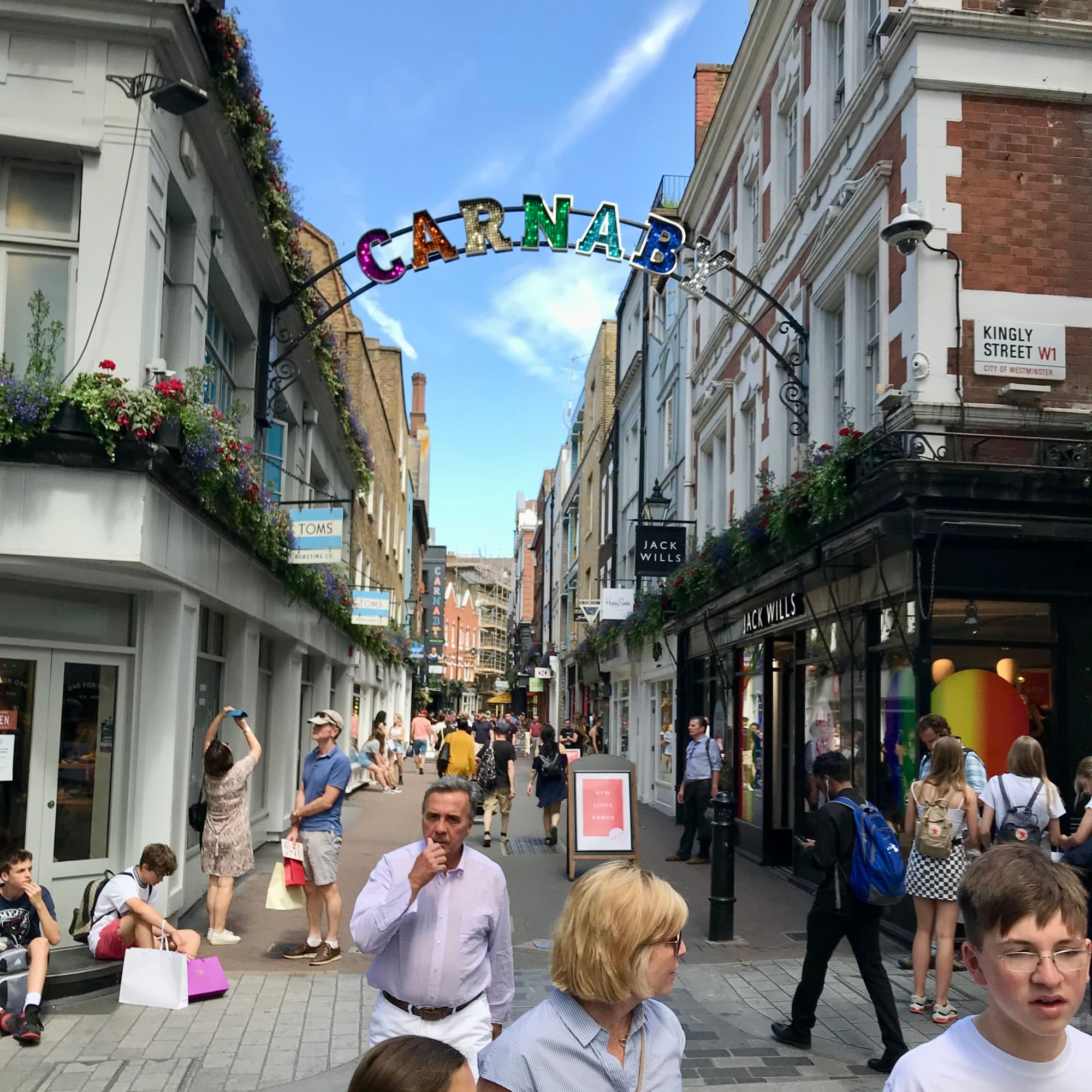


Traveler's Hack: When taking a flight across seas into a different time zone, plan your flight out so that you're leaving the night before, specifically if trying to avoid taking off an additional day of work AND landing at your destination early in the morning so that you have an entire day ahead of you. For example, London is six hours ahead of Boston and the flight is roughly seven hours long. With a flight taking off at 8:00 pm from Boston, you will land in London at 9:00 am, ready to start the day exploring the city. We recommend forcing yourself to sleep your entire flight so that you are well-rested once you land. You can take melatonin on red-eye flights and the following nights abroad to help adjust to time zones and prevent jet lag.
Once you land, you will need to go through the entire Customs protocol, and once cleared from the Authorities, head towards the Tube, which is what the metro system in London is called. After clearing customs, it’s a straight shot towards the entrance to the Tube, which is connected to the airport. Talk about optimized transportation! This metro system is the BEST in the world for a reason, and probably the easiest public transportation system we've ever used. We highly recommend it to anyone who is trying to get around London. In order to figure out schedules, simply use Google Maps. Input where you are trying to go and select the public transit option to find your quickest route. It really is the best way to get out of the airport and around a lot of the city.
Traveler's Hack: We recommend using a travel backpack that is an ANTI-THEFT Backpack when traveling in foreign cities, and keeping most of your belongings in the pack and out of your pockets. As a tourist, you're a target for pickpockets, especially in popular sightseeing locations and metros that are full of people and other tourists. It’s important to be smart, be ALERT and keep guard of your most valuables.
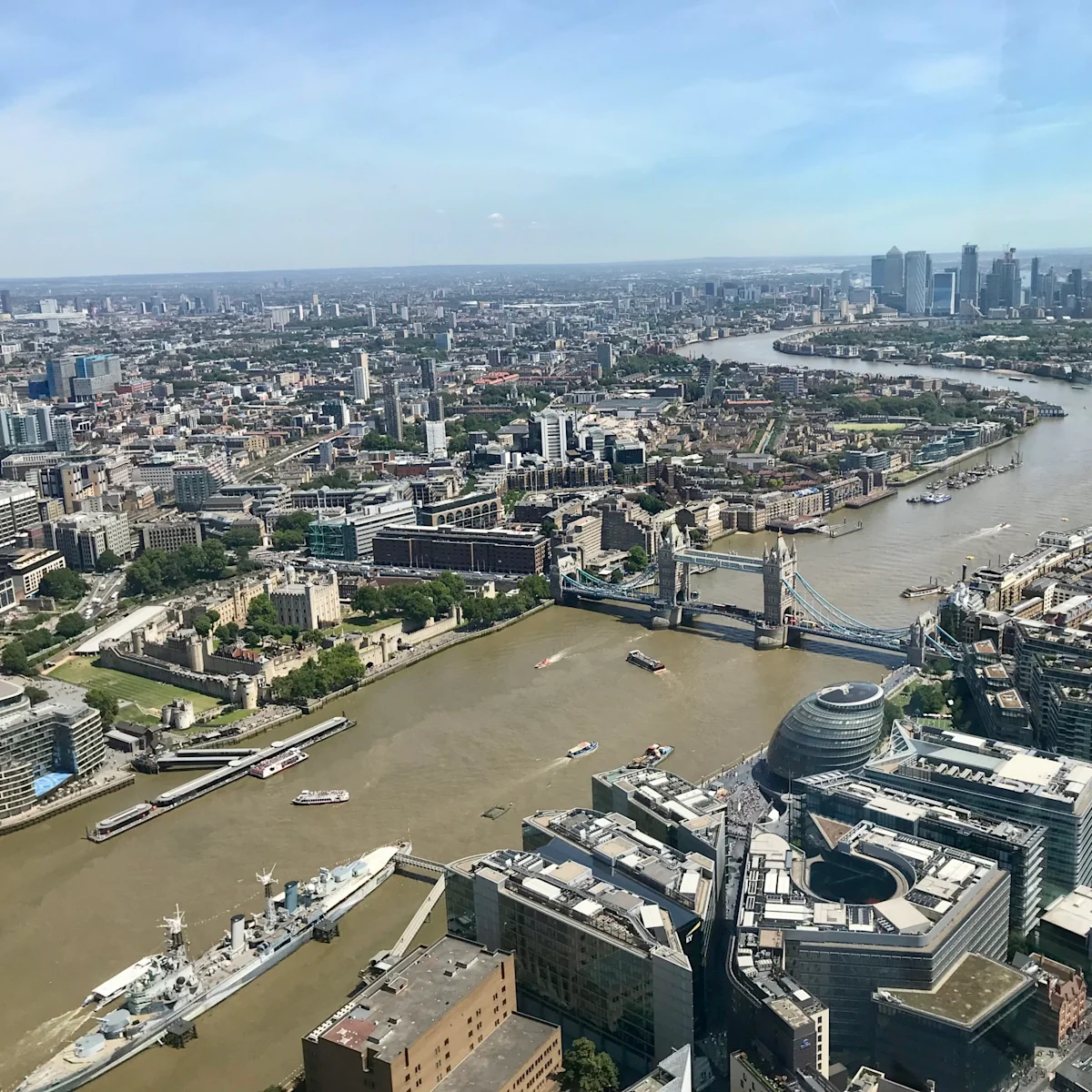
Now, it's time to be a full-blown tourist and make your way to all the major landmarks in the city, using your London Pass. First stop is Leadenhall Market, which is a cool little market due to its architecture and decor, however, a main interest in the market is the fact that it was used in Harry Potter and the Philosopher's Stone to represent the area of the Leaky Cauldron and Diagon Alley.
Traveler's Hack: Map out all these stops in the weeks before leading up to your trip. Depending on what your plans are heading into a major city, lots of cities offer a city pass. This is basically a bundle of entrance tickets to the city's main attractions at a reduced cost than buying them separately.
Once you have seen the market and purchased trinkets, walk over to St. Paul's Cathedral, which stands at 365 feet high, making it the tallest peak in London from 1710 to 1963. The Cathedral is beautiful on both the inside and outside. The architecture of cathedrals will draw your eye, the fine details on the outside along with the arches that look atheistically pleasing but all serve the function of supporting the massive weight of the building, and you can't forget about the iconic dome structure near the center of the building.

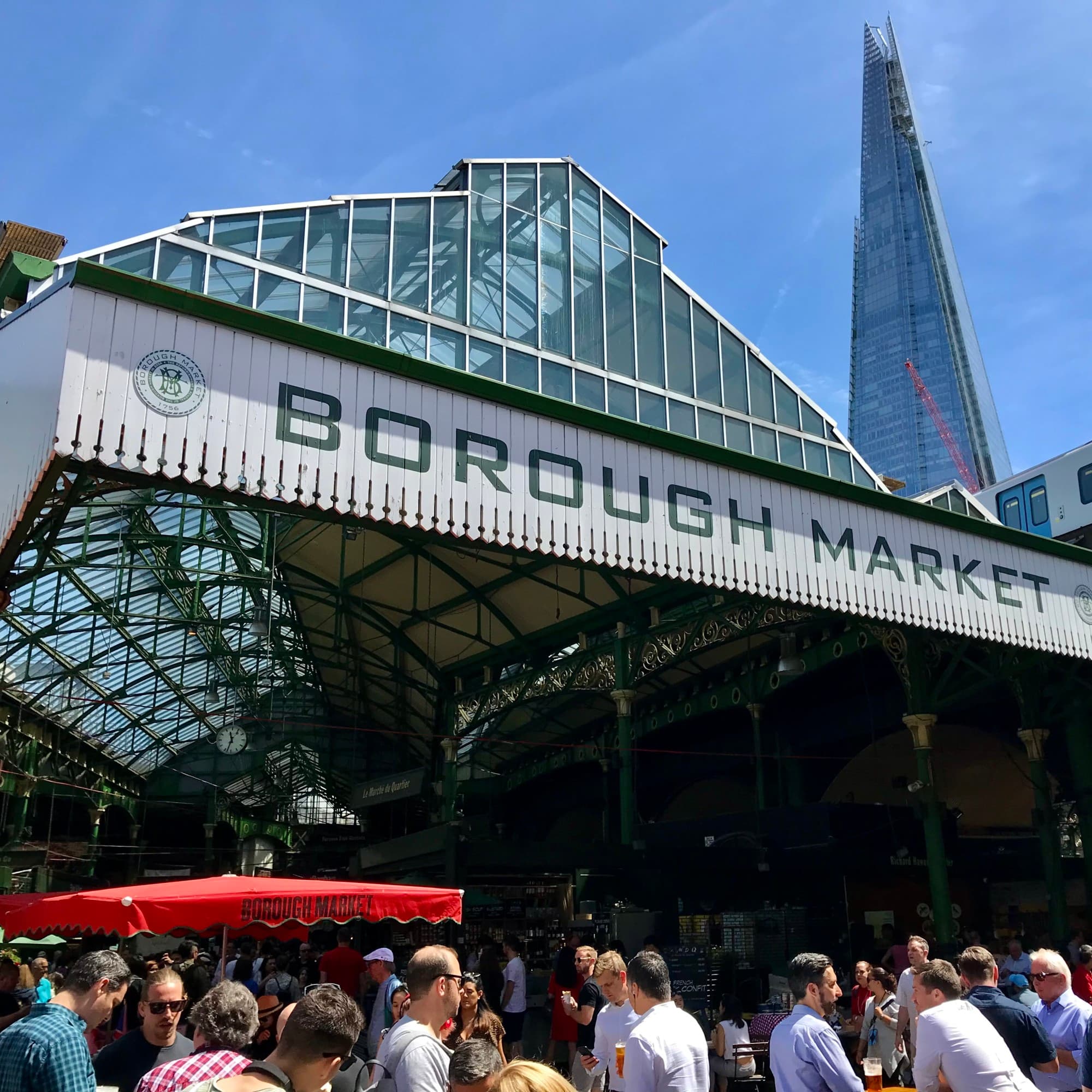


Crossing the River Thames using the Millennium Bridge, a steel suspension bridge for pedestrians, is really special. To be walking across a bridge that has been in a TON of different movies, is pretty spectacular. If you're a Harry Potter fan, you may recognize this bridge as the one that collapses following an attack from the Death Eaters. The bridge also makes an appearance in Guardians of the Galaxy during the climactic battle on Xandar.
On the other side of the river, you will see the Globe Theater, a theater famed for being associated with William Shakespeare. However, the building you see today is a modern reconstruction of the original Globe Theater, which was constructed in 1599, and unfortunately burned down in 1613. It was reconstructed the following year in 1614. If you're fascinated by theater and literature, this would probably be a good stop for you.
From here, continue your journey through the city to the famed Borough Market. This place is full of a bunch of great places to eat, however, Roast has a delicious pork belly sandwich.
After satiating your appetite, keep your journey going by making your way to the Shard, which stands at 1,016 feet high and makes it the seventh tallest building in Europe. Not only holding that title, but it also holds the title to the tallest building in the United Kingdom and EVEN in Western Europe. Pretty cool, right? Use your handy city pass to gain entrance into this building and to access the top of the skyscraper.
Since London is pretty flat, with almost no skyscrapers in comparison to some of the American cities, the views are not obstructed from other towering buildings. Having such an advantage gives great aerial views of the city. You can pick out the Tower of London, Tower Bridge, the London Eye, the financial district and other parts of the city to take many great photographs.
After hanging out at the top of the Shard for about an hour, head back down to the base of the building and start walking towards Tower Bridge. The Tower of London, is a great stop. This city has been through much turmoil. What you may find interesting is that each of these guides for the tour are Yeomen Warders, more popularly known as the Beefeaters, the ceremonial guardians of the Tower of London. They are responsible for looking after the Tower's prisoners, safeguarding the British Crown Jewels and have conducted guided tours of the Tower since the Victorian era. To become a Yeoman Warder, you must have served in the Armed Forces of the Commonwealth realms, with at least 22 years of service and be a former warrant officer with a Long Service and Good Conduct Medal. Clearly, this is a tough position to grab and they take their duties extremely seriously! However, to witness it in person is quite spectacular. During your tour, head out to the public outdoor areas of the Tower. Places such as the Battlements, the Medieval Palace, Bloody Tower, Torture at the Tower exhibition and some floors of the White Tower.
The Tower was built in 1078 by William the Conqueror and was used as a prison from 1100 until 1952. Although its primary use early-on was as a royal residence, with several buildings set within two concentric rings of defensive walls and a moat, it has an interesting history. The Tower served as an armory, a treasury, a menagerie, home of the Royal Mint, a public record office and home of the Crown Jewels.
In the later 16th and 17th centuries, it was used as a prison for disgraced figures such as Elizabeth I, Sir Walter Raleigh and Elizabeth Throckmorton, which led to the phrase "sent to the Tower." Although it gained a reputation as a place of torture and death, only seven people were executed within the Tower before the World Wars. The executions were more commonly held on the notorious Tower Hill, where 112 executions occurred over a 400-year period. During WWI and WWII, 12 men were executed for espionage.
After finishing the tour, make your way over to Buckingham Palace and see the Crown Jewels. The city pass may include a ticket onto a 48-hour red bus tour. If so, hop on a bus that will take you to the Buckingham Palace stop. It's a great place to take some photos of the palace, then walk over to the Churchill War Rooms.
Traveler's Hack: If you're someone who doesn't love planning but still wants to make the most of their time spent in the city without doing too much research, we recommend hopping on a red bus tour. As soon as you land in a city or new location, buy a ticket to a 48-hour red bus tour and hop on the bus. These busses will take you to each of the city's top attractions and usually will include an audio recording that you can listen to to gain context into what you're seeing at each stop. Every time the bus reaches a stop, you have the ability to hop off and explore that attraction, then hop back on a new bus as soon as you finish.
The Churchill War Rooms is a museum that comprises the Cabinet War Rooms, the historic underground complex that housed the British Government Command Center throughout WWII, and it also has the Churchill Museum, a biographical museum of the life of Winston Churchill.
This museum is led by a guided audio tour, so it is self-paced. It is so fascinating that Churchill basically led Britain through WWII in these tiny underground Baracks, due to all of the bombings that were taking place above-ground, and were used until August 1945 after the surrender of Japan.
Spend a few hours in the war rooms, soaking in the history of what took place in these walls, and learning about Churchill himself, then head over to take a look at Westminster Abbey, Big Ben and the London Eye.
At this point, if you're getting hungry, try this Egyptian restaurant, Yalla Yalla, and order the Kafta Meshoue plate. Which is a spiced lamb salad plate that will really hit the spot. If you have the energy for a night out on the town, we suggest Tiger Tiger night club.
On day two, start your day with food from Camden Market Area, where you can find some amazing Indonesian food from Pino's Warung. After your meal, walk around the market and look at some of the shops in the area and take this opportunity to snap photos at the same time.
Next, hop on the Tube to make your way over to Hyde Park. On your way there, make a quick stop at Piccadilly Square. This stop is somewhat reminiscent of Times Square, with the digital billboards along the buildings that encompass the street and hover above it all. Walk down Carnaby Street, which is festive and alive with pedestrian traffic, make a stop to grab meat pies at a Mother Mash. Ladies and gentlemen, this is the place of all stops. As the name implies, it’s a pie that's stuffed with the meat of your choosing. Try the steak, and let us tell you, it is amazing!
After getting your fill of food, head to Hyde Park, which is a massive 350-acre park. It holds the title as the largest royal park in London, located in the center of the city that also contains the Kensington Palace and Gardens within it. That’s not to forget there is a huge lake in the center of it. The park has been known for holding demonstrations, protests and even large-scale rock concerts that featured Pink Floyd, The Rolling Stones and Queen. We found the park similar to that of Central Park in New York City, although much cleaner.
When approaching Kensington Palace, you will notice the gardens that surround the palace are extremely well-kept, featuring many pretty flowers and plans. Make a stop at Harrods' shopping center and see what all the hype was about. The mall is pretty extravagant and features plenty of high-end shops.
Make reservations to have dinner at Dishoom, a small-plate Indian restaurant in Covent Garden. This has some of the most delicious Indian food! Order the fried green chilies, Seekh Kabab, gunpowder potatoes, basmati rice and Murch Malai. Share all of the different plates all while washing it all down with beer.
After dinner, get ready to go out to the Ministry of Sound, a legendary venue. If you're a house and electronic fan, this needs to be a stop for you.
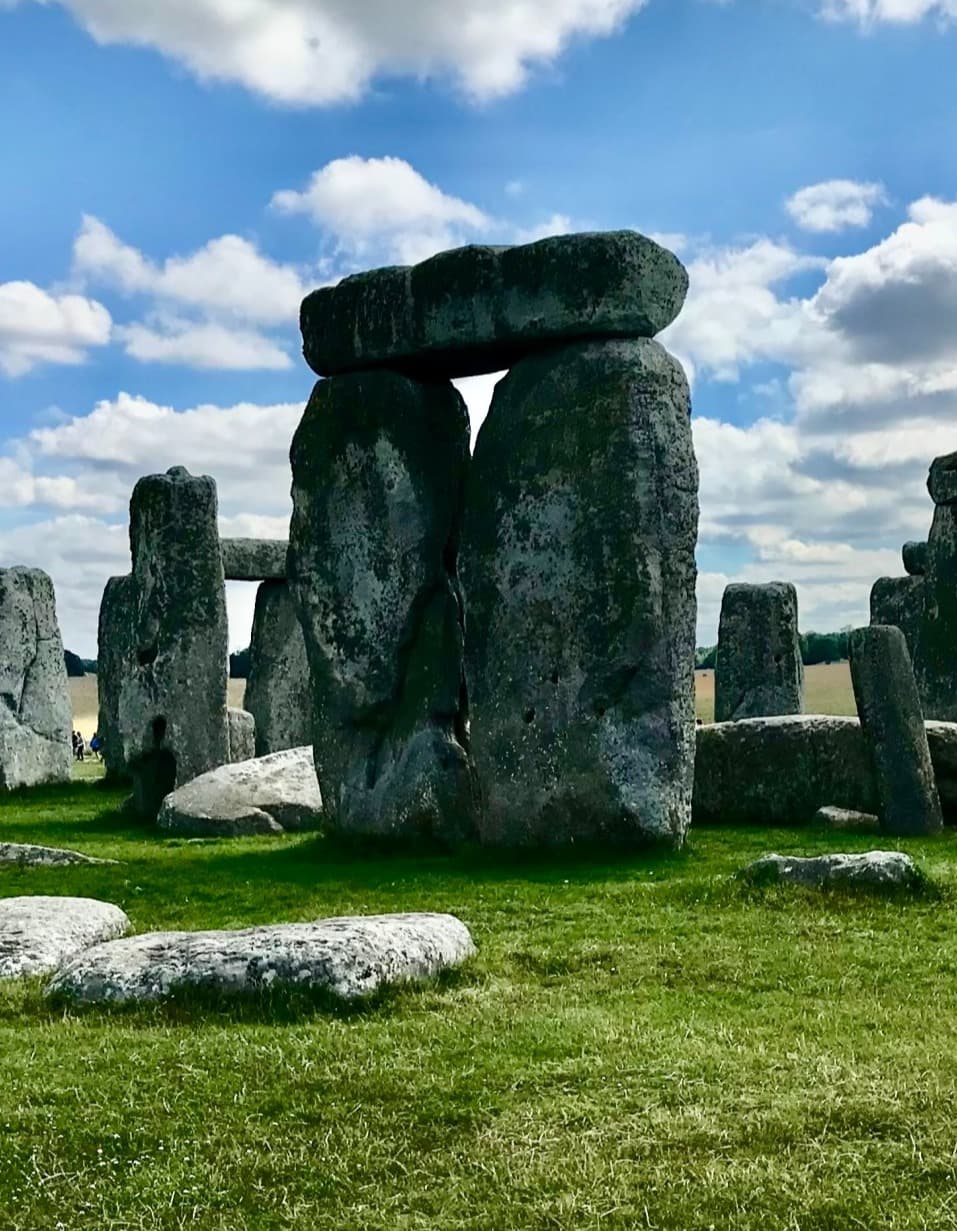
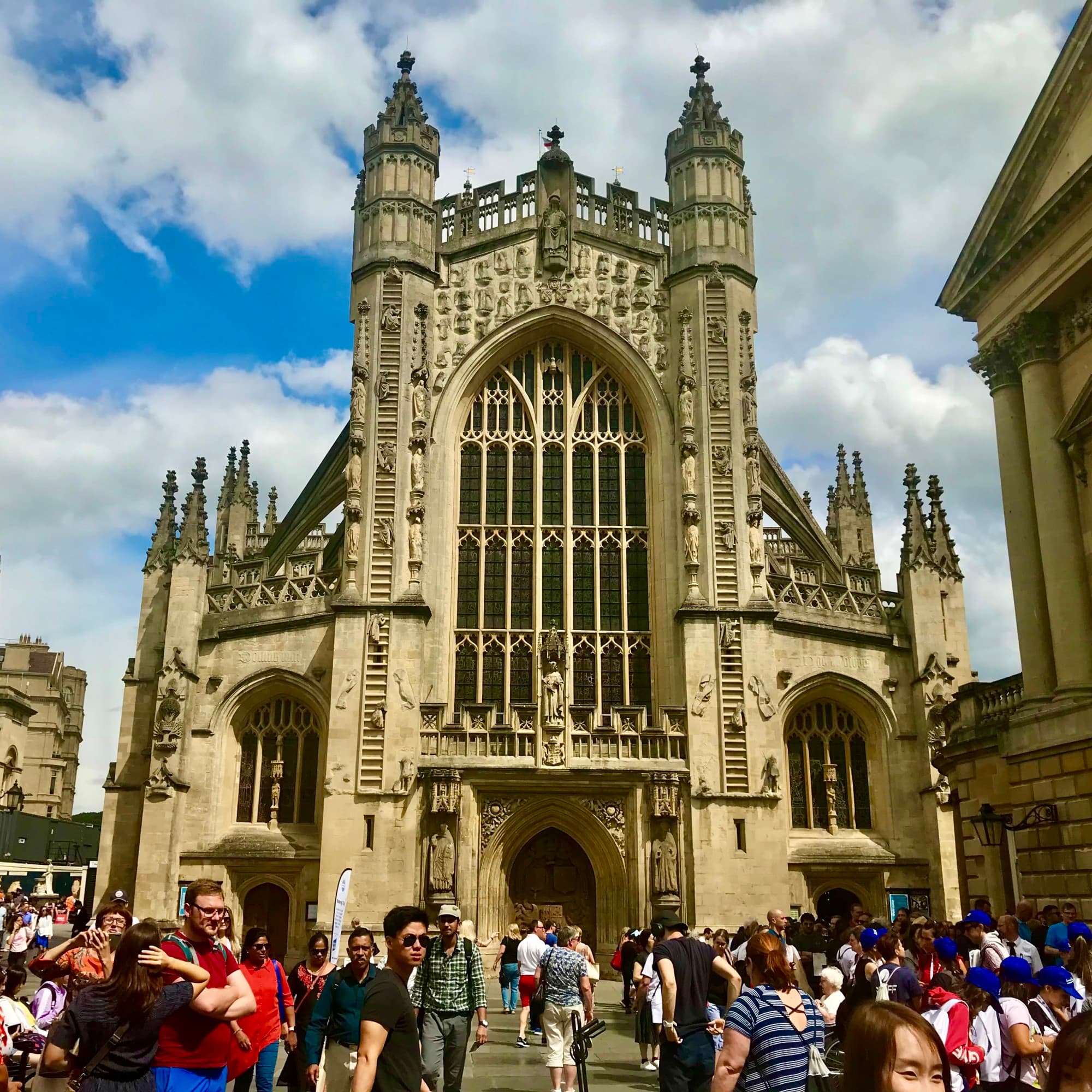


On day three, book a trip to see the Stonehenge and Bath Day Trip Tour. Once you meet your tour guide and group, you will hop on a charter bus (which is included with the tour). The ride from London to Stonehenge is only about two and a half hours. Along the way, the tour guide will point out a few things about the surrounding landscapes and things passing by, as well as facts regarding Stonehenge.
Once you arrive at Stonehenge, which is literally off the highway and in the middle of nowhere, you will hand your tickets in at the park entrance and collect your audio guides, both of which are included in your tour. Listening to the audio recording, you will learn many things. For instance, no one really knows how or for what purpose Stonehenge was built, since the civilization that constructed this monolith left no written records. However, it's theorized that it served as either an astronomical observatory or as a religious site.
Archaeologists believe Stonehenge was constructed from 3000 BC to 2000 BC, with it consisting of an outer ring of vertical Sarsen standing stones, each 13 feet high, seven feet wide and weighing around 25 tons that were topped by a connecting horizontal lintel stone. Inside of this is a ring of smaller bluestones, followed by bulkier free-standing trilithons. The arrangement of this encompassing horseshoe with five central trilithons, the heel stone and the embanked avenue are aligned to the sunset of the winter solstice and the opposing sunrise of the summer solstice. Supporting the claim that this site was used for astronomical or religious purposes (or even both).
Seeing these massive stones really makes you wonder how they were able to get these towering rocks in place, considering its construction took place over 4,000 years ago without the assistance of modern technology. It is easy to see how some of the theories became conspiracies. Regardless, it is extremely cool to see this monument up close and in person. After circling the structure and finishing up the audio tour, you will head back to the visitor center to hand in your audio tapes. There is a small café inside of the center, grab a quick coffee and water to keep moving for the rest of the tour.
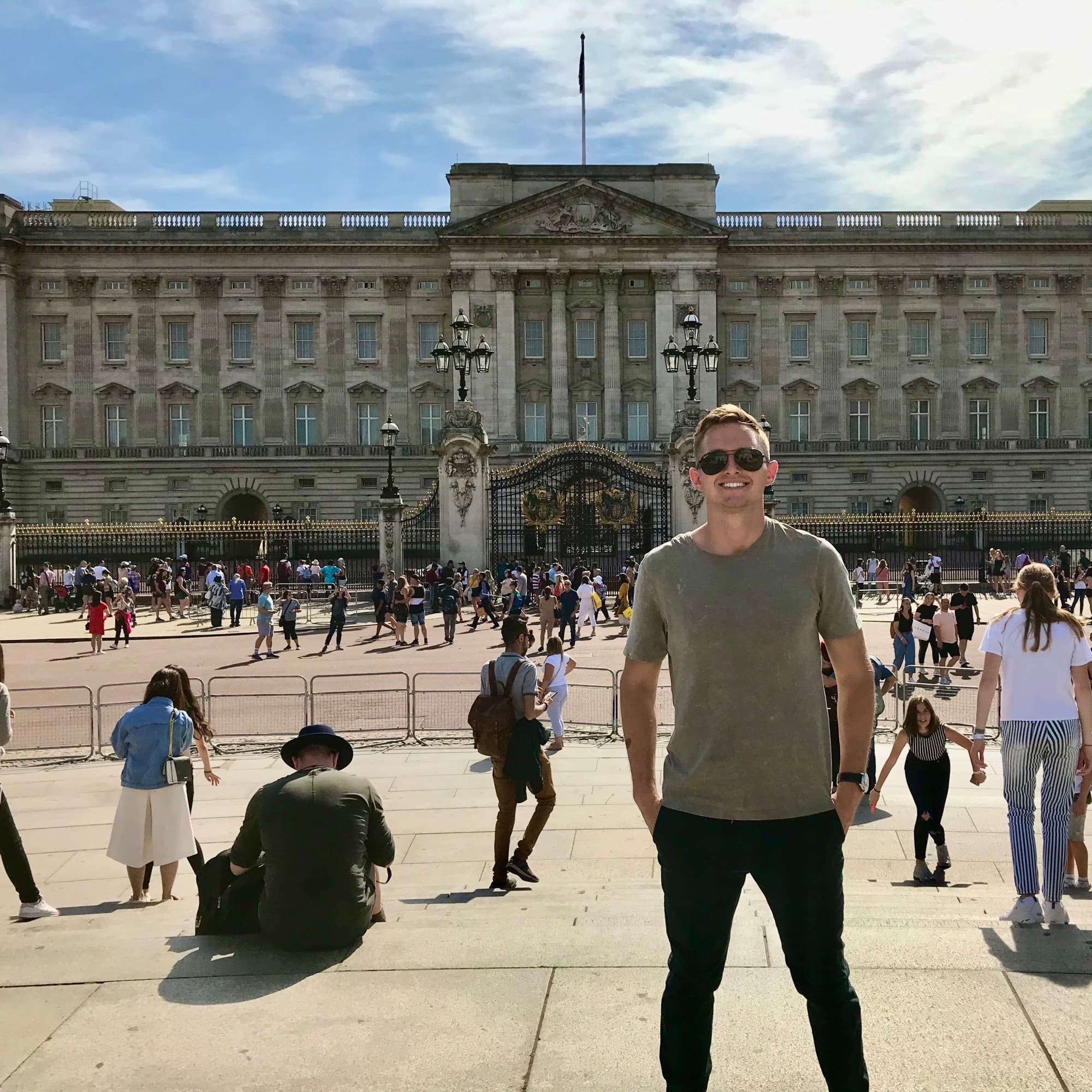
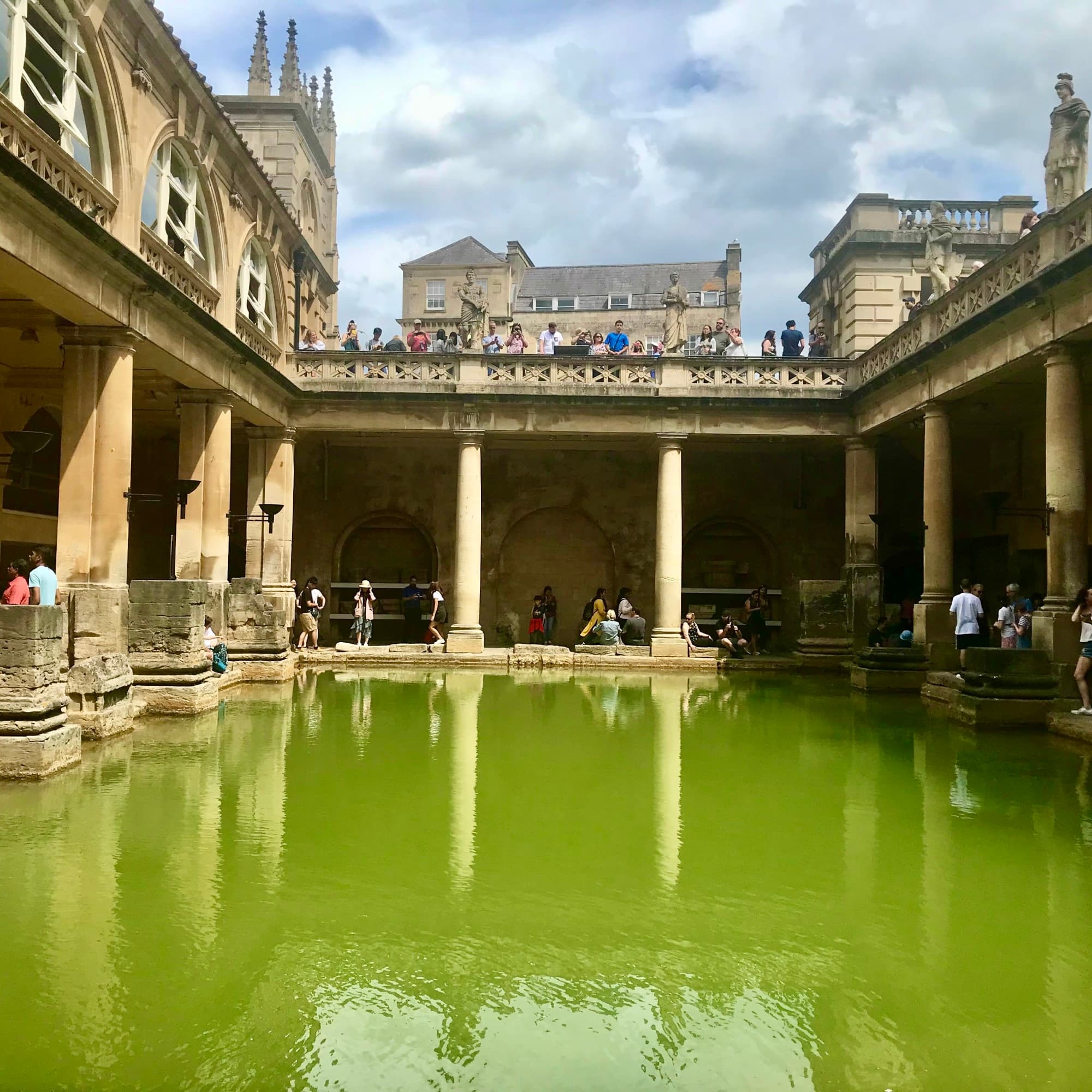


Hopping back onto the tour bus, the guide will take a quick headcount. The threat of being left behind in the middle of nowhere can be an effective deterrent for tardiness. With everyone on board, the next stop is the city of Bath. The small town is best known for its Roman Baths. The architecture of the town and the history behind the baths are very interesting.
Before exploring the city, your guide will give you a specific time to meet back at the bus for departure, then provide you with recommendations on what to do in the city along with places to eat. The nearest restaurant with decent reviews is The Old Green Tree, which is a quaint local pub. Try the fish and chips (highly recommend this simple dish while visiting the United Kingdom).
After lunch, head over to the entrance of the Roman Baths. The baths themselves were quite large. They were built around 60 AD over the springs, and were thought to contain healing properties due to the minerals in the water. This, of course, attracted people from all over the empire to come bathe in these waters, a modern day spa treatment if you will. Inside of the building there are different chambers, some used as saunas and others used as a cooling chamber. One interesting bit of information that you may find extremely gross was that they collected the sweat and oils from the hot chamber to be used for cosmetics.
If you have time to spare after completing the tour, walk around the small city, taking in the beautiful architecture of the Bath Abbey (the Cathedral in the center of the city) before moving on to the River Avon. It’s quite peaceful and relaxing here. With your day coming to a close, make your way back to the bus so you don't get left behind. Once on board, your guide will take a quick headcount, then you're off to London. Once back in London, try dinner at Bull In a China Shop.
On day four, start your day with brunch at Sketch, which is known for its artsy décor and egg-like bathrooms. The place itself is very imaginative with its artistic displays and each room having its own theme. The establishment is known for having artists make additions to the rooms while they are open, so you may catch an artist at work.
Traveler's Hack: Make sure if you plan activities like brunch (which usually involves alcohol) the day of your international flight back home, that you have everything packed and have mapped out how long it will take you to get to the airport. We also recommend giving yourself an extra hour of wiggle room (three hours before your flight) to make it to your check-in time before your flight with plenty of time to spare.
Need to know
Some of the highlights of London is seeing all the historical sights associated with British Monarchy, especially the Churchill War rooms. If you’re a history buff this is a must see.
This trip report is part of our ongoing series on travel to London. In need of further inspiration? Check out Neil McPherson’s guide, Best Boutique Hotels In London.

The Modern Travel Agency
Fora

Reach out to a Fora Advisor.
Did you like this guide? Reach out to customize and book your own experience with a Fora Advisor. Or, to chat about travel in general.
You can expect a response from Fora within 1–2 business days. You’ll also be subscribed to our traveler newsletter (you can unsubscribe at any time).